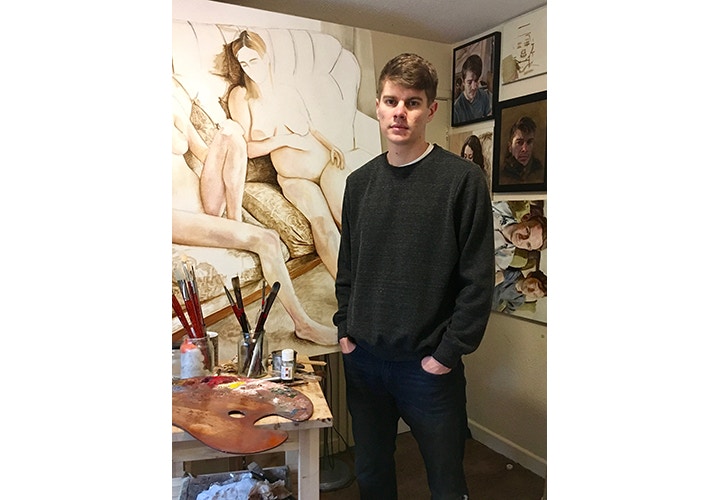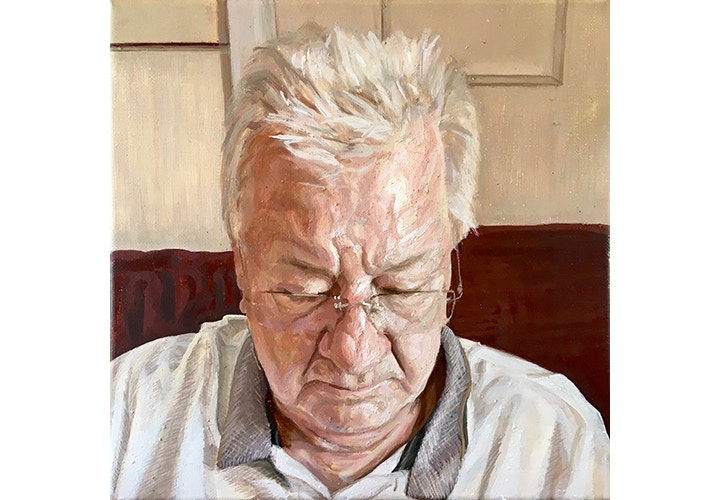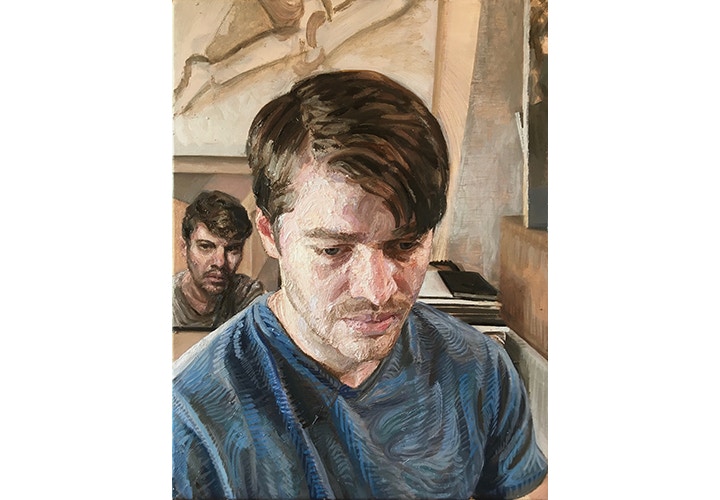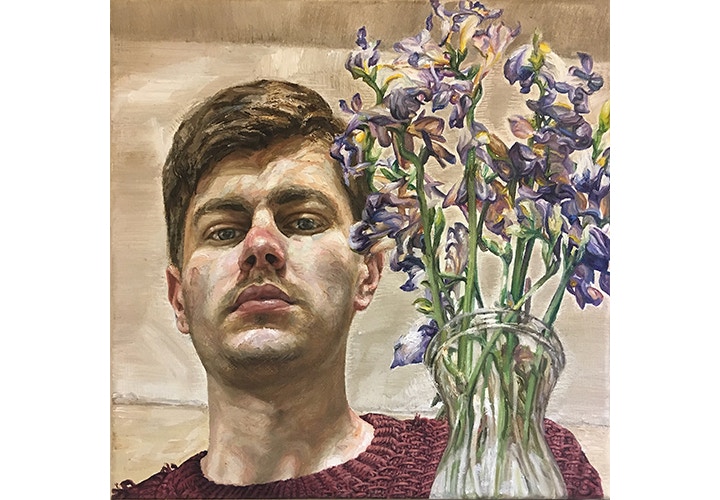Art in Isolation: Owain Hunt
Posted by Cass Art on 14th May 2020
These are very strange and uncertain times for us all. The idea of the unknown is a difficult place to be in. This period in our lives will be the utmost test of our mental strength and courage. It’s really no surprise that in times of unease we turn our attention to fictional stories which in most cases have a relative comfort resolution to distract us from what’s going on outside and in some cases inside our front doors. In this series Art in Isolation each week we want to speak to different artists and creatives from around the art world to see what they’re doing during this period of self-isolation whether they’re making, reflecting or simply taking a break. To see what this time means to them personally and professionally. Also, what art means to them, something that shouldn’t be forgotten.
Owain Hunt is a British figurative portrait painter. His path towards becoming a professional artist was unconventional. He honed his artistic practice whilst studying for degrees in Economics and History from the University of Bristol, reading, observing and experimenting between lectures. Since graduating in 2016 he has pursued a career as a figurative painter.
Hi Owain, thanks so much for taking some time to chat to us. Firstly, could you tell us a bit about yourself and what inspired you to be an artist?
This is one of the questions I always get asked - as I’m sure most artists do - but it’s very hard to pinpoint. Being an artist is a way of life; an all-consuming, perpetual cycle of engagement and private reflection with the world around you. If you possess a certain combination of traits and tie that in with a high level of introspection, an obsession with external observation, and a tendency to communicate visually, I think that just makes you a (visual) artist. Perhaps it is a question of how far you are willing to embrace that. My personal experience was that as far back as my early childhood I was encouraged to be creative and more importantly, the stuff I drew or made was met with a positive response. I guess that has resulted in that element of my personality becoming more pronounced over time, making it harder to ignore.

What is it that drew you to portraiture?
Fundamentally two factors: an interest in people (and I make that distinction; between painting people and painting portraits as I think there is a formality and therefore inherent superficiality associated with the latter) and the inclination to engage with society on my own terms. I grew up with nine siblings, so I never felt the need to socialise loads. I always disliked feeling coerced into social situations on the grounds of convention but equally found talking to people and analysing socio-cultural differences interesting. Painting people is a manifestation of those two sides of my personality: It is a good way to get to know someone in a situation I have control over, and the by-product is a social document with my reflections embedded and obscured. So, that is one side of it; painting people is a way in which I can autonomously engage with the outside word. The other is that I just have an unrelenting existential question hanging over me. I find it very hard to accept that life has little meaning so I try and seek purpose. Self-portraiture is the most enriching medium I have found to abate that feeling; of life lacking meaning. When I no longer want to confront those thoughts head-on, I am very fortunate in that I can still paint people other than myself because I have so many family members. In this way I suppose I am drawn to painting people as a form of self-scrutiny.

A largely distinctive feature in your work is the manner in how you portray emotion. No smiles, frowns, your portraits give little hint of a giveaway of their emotion. Could you talk to us about this and your relationship with the sitter/subjects you use?
When I paint, I try and concern myself with the act of painting. I spent years learning how to paint but learning how to paint is simply learning a craft. The goal has to be to convey a connection; to imbue emotion in a painting by capturing an essence of what it is to simply be existing with a sitter. It has taken me a while to fully embrace that realisation: In the past I sought tools, techniques and theory as a foundation to build from, like a musician learning scales or something, but eventually I got so obsessed with the technical side of painting that it became detrimental to what I was and still am trying to achieve. Now I understand that when someone sits in front of you and you have a conversation with them, something dynamic inevitably emerges; I react to the sitter’s reactions to me, or the subject of conversation, and to my life circumstances. Thus the work is both reflective, and a self-reflection; It is a social commentary, but it is also autobiographical.
I suppose this interplay, combined with my tendency to work over a long period of time, has resulted in a contradiction of sorts because when you interact with someone over several months you witness their different moods and learn how they convey emotion. With every sitting your sitter becomes more complex, and your relationship more honest, yet the image that emerges is oddly often emotionally ambiguous. Although the facial expression in the final picture is ostensibly neutral, every layer encapsulates an essential truth. I think that is the trait that all great pieces of art possess: they can be universally received because the emotion derives from the process of its creation, not from the image itself; it starts with the painter-sitter relationship and manifests in the audience’s emotional engagement. Simply showing a smile or a frown risks cutting that engagement short and limiting the audience’s connection with the piece because they already ‘know’ what it says before they have thought about it. It is like the difference between arriving at a destination and going on a journey.

What materials do you use and why are they important to your practice?
My pictures probably have two overriding features (currently); They naturally become more layered with every sitting, and I try to load each mark with as much emotion as possible. I want every mark to be a physical record; traces of an existence. Therefore, I choose materials that can manipulate paint, as long as they also facilitate a level of permanence - otherwise I might as well be drawing in the sand. To this end, I use anything from egg yolks to mastic varnish, turpentine, Michael Harding’s Resin-oil Medium, chalk, ground charcoal, beeswax paste and heavy metal-based pigments with a low oil content. I also stretch, size and prime my own canvases because I am rather fussy.
Can you talk to us about this period of self-isolation? What are you doing with your time, whether it be making or reflecting?
I actually self-isolated before the lockdown was enacted so I have been detached from the outside world for quite a while. When the lockdown was initiated, I was working on a self-portrait, as well as a few commissions. Once those paintings came to a natural finish, or sittings were put on hold, I found the lockdown to be rather suffocating and my productivity plummeted. At that point I decided to take time out to reflect and discover new work. I have continued to tick things over to a degree; making daily self-portrait studies and a few preparatory sketches, exploring future compositions etc. but there has been a marked difference from my usual working hours.

Why is this time important to you and your practice?
I hope I will look back on this time as an important moment to reflect on why I actually create art. For a long while I noticed myself becoming detached from my paintings as I was making them, to the extent it started to show in my work. I got to the point where I was going through the motions, painting for the wrong reasons. Now I understand that a painting is finished once I am no longer emotionally invested in it, regardless of how ‘finished’ it looks. The most notable positive from the quarantine has therefore been the opportunity to step back and reconsider why I even paint. It has been a rare opportunity for considered introspection.
We’re obviously in a strange place right now. Do you have any advice for anyone struggling with finding their creative flow?
My overriding advice would be not to fret. This is the first time I have experienced something resembling ‘painter’s block’ yet I would say my work has become more thoughtful in recent weeks than in the last year. Usually my first port of call would be a trip to a gallery or exhibition, but obviously that is currently unfeasible. Instead, I have dipped into art books or watched documentaries. Keeping a routine is also very helpful. Try and paint or draw every day, a loose sketch every morning is a good way to become more throwaway with your work. No one has to see your sketches if you do not want them to, but they are a great way to record your thoughts. Have a range of supports, sizes and materials in the studio and scribble down ideas as soon as you think of them. Revisit your material and you will usually learn something new. Always push new boundaries and try and find artists that you have never appreciated before. Ultimately, just keep observing and analysing and eventually you will find inspiration again. It is hard to suggest much more than that. My aim is to make art that is intrinsically honest to myself, and to date those are the mechanisms that have been most conducive to that.

In the current climate I think it’s always important to reflect on topics as broad as this. But why art is important to you?
Art is an existential pursuit. It gives me purpose. I think there’s something sad about having a life with no trace, and aside from having children the only trace I can think of is art. If I was good with words, I would be a writer. I just happen to be better with pictures, so I do that.
See more of Owain's work here.
Shop online for everything you'll need. Don't forget to hashtag #cassart on social media to show us your creations.
So we’re still in self-isolation and maintaining social distancing which is ironically the most basic act of human social solidarity right now. What does help is arts unique resourcefulness of social connectivity to keep us symbolically together yet physically apart.
“If you hear a voice within you say ‘you cannot paint,’ then by all means paint, and that voice will be silenced.”
– Vincent van Gogh



